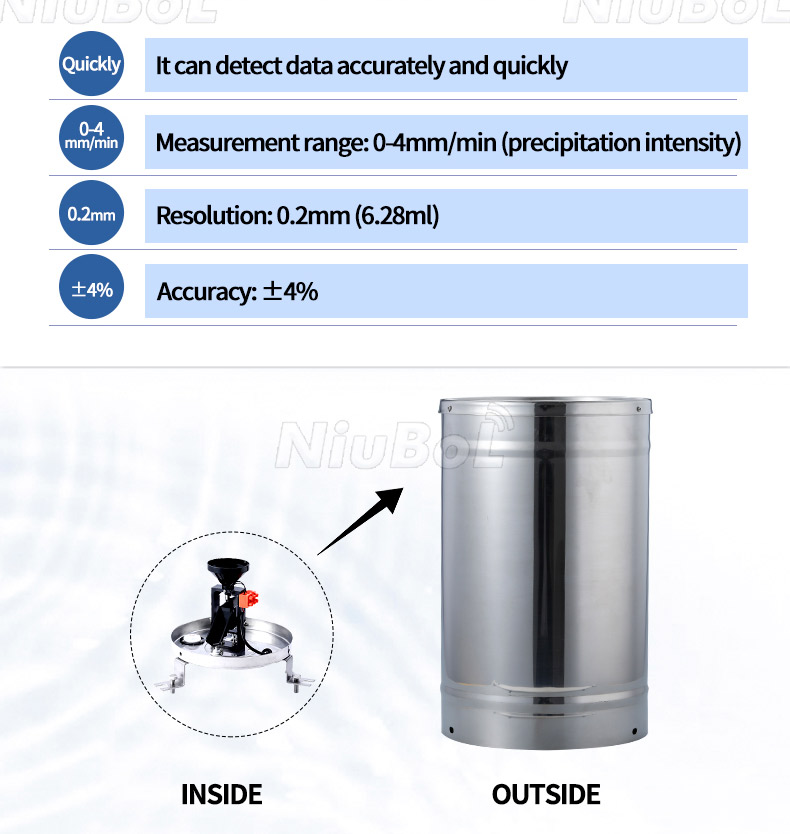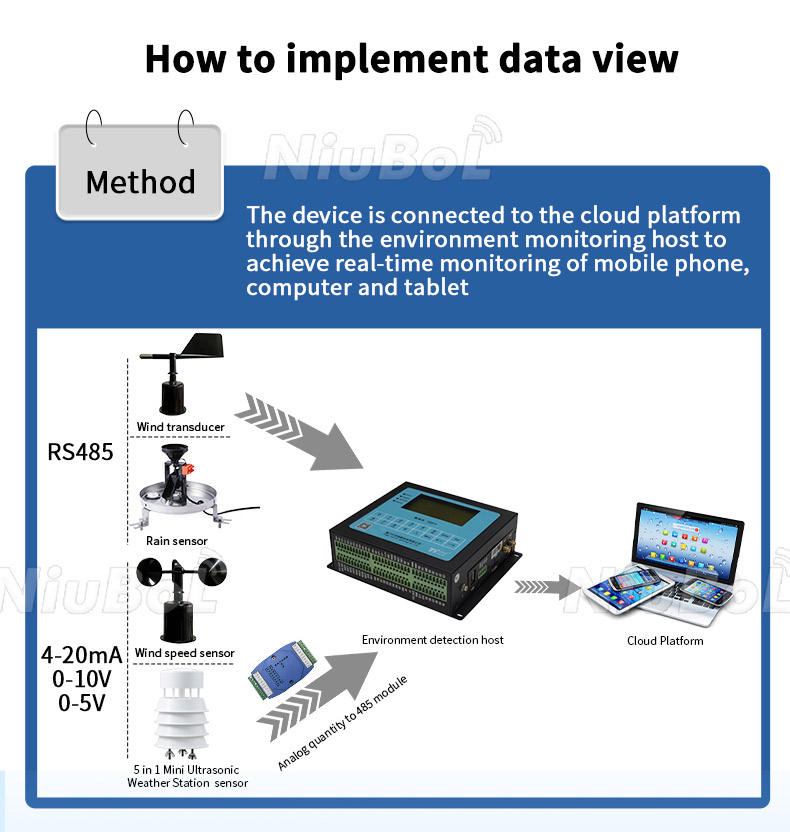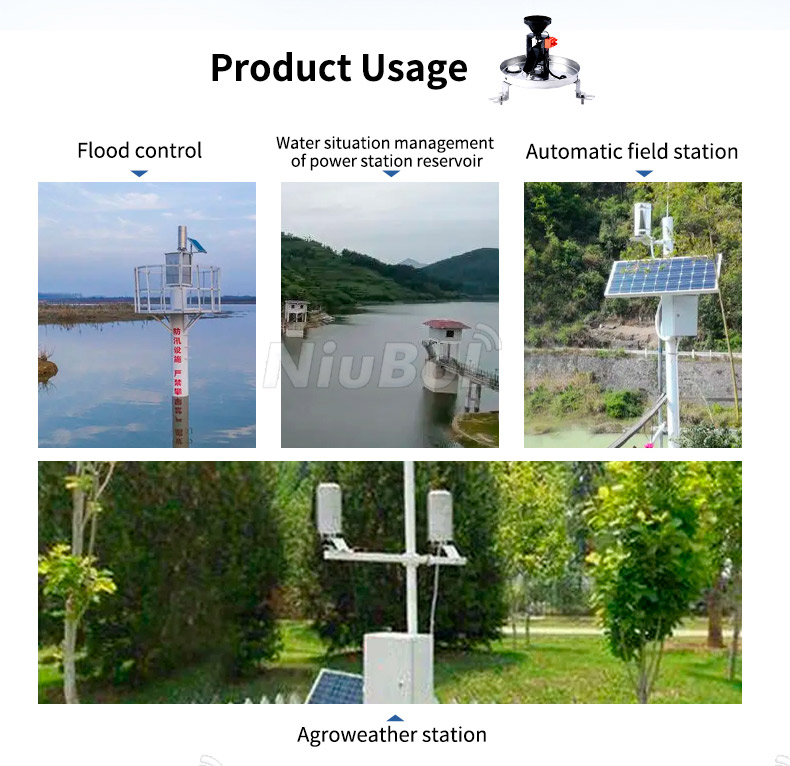

— Blogs —
—Products—
 Consumer hotline +8618073152920
Consumer hotline +8618073152920 WhatsApp:+8615367865107
Address:Room 102, District D, Houhu Industrial Park, Yuelu District, Changsha City, Hunan Province, China
Product knowledge
Time:2023-07-23 10:36:21 Popularity:1714
Rainfall monitoring systems can use different methods to detect rainfall. Below are a few common rainfall monitoring methods:
Rain Gauge: A rain gauge is a common and commonly used rainfall monitoring device. It usually consists of a funnel-shaped receiver and a measuring device. As rainwater flows through the funnel into the receiver, the measuring device records the amount of rainfall. Based on the recorded time and rainfall accumulation, rainfall intensity and total rainfall can be calculated.
Vibrating Rain Sensors: Vibrating rain sensors use a thin rod to pick up the impact of raindrops and determine the amount of rainfall by measuring the number of impacts or changes in the vibration signal. These sensors are reliable and accurate and are often used in automated weather monitoring systems.
RADAR PRECIPITATION ESTIMATION: Radar precipitation estimation is a rainfall monitoring method based on radar technology. By transmitting microwave signals and receiving their reflected signals, radar uses the characteristics of the signals to identify areas of precipitation and estimate rainfall intensity. The radar precipitation estimation method can provide rainfall information over a wide area range and is suitable for large-scale rainfall monitoring.

Satellite Remote Sensing: Satellite remote sensing techniques can utilize satellite sensors to measure microwave radiation in the atmosphere to derive rainfall. Satellite remote sensing methods can provide rainfall monitoring on a global scale and have the advantage of real-time and wide coverage.
These methods can be used individually or in combination to improve the accuracy and reliability of rainfall monitoring. In setting up a rainfall monitoring system, the selection of suitable monitoring equipment and methods needs to be based on actual needs and budgetary considerations.

Rainfall monitoring has important value for agriculture in the following ways:
Irrigation management: accurate monitoring and recording of rainfall can help farmers understand the moisture condition of farmland. Based on the rainfall data, farmers can rationally arrange irrigation schedules to avoid over-irrigation or under-irrigation. Through effective irrigation management, not only can water be saved, but also the growth effect and yield of crops can be improved.
Drought monitoring: Rainfall is one of the most important indicators for assessing the degree of drought. By continuously monitoring rainfall, signs of drought can be detected and responded to in a timely manner. Farmers can adjust the cropping structure of their crops according to the changes in rainfall, select crop varieties adapted to drought conditions, or take other irrigation and conservation measures to mitigate the effects of drought on crops.
Crop growth management: Rainfall has a direct impact on crop growth and development. By monitoring rainfall, farmers can keep abreast of the water availability in their farmland and rationally adjust their crop management measures. For example, in the season of high rainfall, the amount of irrigation can be reduced; while in the case of low rainfall, the amount of irrigation can be increased or other measures can be taken to ensure the growth needs of crops.

Agricultural Disaster Early Warning: Rainfall monitoring also helps in early warning and management of agricultural disasters. For areas prone to flooding, mudslides and other disasters, monitoring rainfall can be detected in advance of excessive rainfall or continuous rainfall, and take appropriate disaster prevention and mitigation measures in a timely manner to protect farmland and crop safety.
In conclusion, the value of rainfall monitoring for agriculture is to help farmers rationally manage irrigation, cope with drought, adjust crop growth management strategies and prevent agricultural disasters. By accurately understanding and utilizing rainfall data, farmers can improve the efficiency of farmland water use, optimize crop production management, and thus improve crop yield and quality.
Prev:Agrometeorological monitoring instruments for determining wind speed and direction
Next:Sensors and instruments for measuring airborne concentrations of PM2.5&PM10
Related recommendations
Sensors & Weather Stations Catalog
Agriculture Sensors and Weather Stations Catalog-NiuBoL.pdf
Weather Stations Catalog-NiuBoL.pdf
Related products
 Combined air temperature and relative humidity sensor
Combined air temperature and relative humidity sensor Soil Moisture Temperature sensor for irrigation
Soil Moisture Temperature sensor for irrigation Soil pH sensor RS485 soil Testing instrument soil ph meter for agriculture
Soil pH sensor RS485 soil Testing instrument soil ph meter for agriculture Wind Speed sensor Output Modbus/RS485/Analog/0-5V/4-20mA
Wind Speed sensor Output Modbus/RS485/Analog/0-5V/4-20mA Tipping bucket rain gauge for weather monitoring auto rainfall sensor RS485/Outdoor/stainless steel
Tipping bucket rain gauge for weather monitoring auto rainfall sensor RS485/Outdoor/stainless steel Pyranometer Solar Radiation Sensor 4-20mA/RS485
Pyranometer Solar Radiation Sensor 4-20mA/RS485
Screenshot, WhatsApp to identify the QR code
WhatsApp number:+8615367865107
(Click on WhatsApp to copy and add friends)
